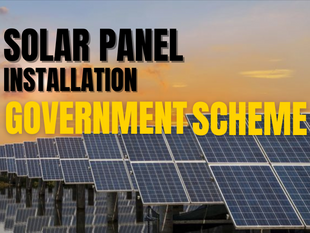
How Solar Panels Work: What Most People Don’t Know
Jun 13
4 min read
1
9
0
Solar panels are more popular than ever before. You spot them on rooftops, out in fields, on factories—even in villages. But have you ever stopped and thought, "How do solar panels work, anyway?"
If you're considering making the switch to solar power or are simply curious about the tech, then this blog is for you. We'll explain it in simple terms, step by step, no jargon. By the end, you'll know exactly how solar panels work to harness sunlight and convert it into usable electricity.
What Do Solar Panels Actually Do?
Simply put, solar panels convert sunlight into electricity. That's it. But what occurs within those shiny panels is a beguiling blend of science and engineering.
These smaller units combine together to form individual solar panels. Solar cells are typically constructed from a material known as silicon. Silicon is excellent at trapping sunlight. When sunlight comes into contact with these cells, it dislodges electrons. These electrons in motion generate an electric current—and that is your electricity.
The 4-Step Process: How Solar Panels Work
Now let's go through the entire process in four easy steps:
1. Sunlight Hits the Solar Panels
When the sun shines on your roof, the solar panels collect it. The sun's energy is transferred directly into the solar cells, where the actual work takes place.
2. Electricity Is Made
Within every solar cell, there's a process known as the photovoltaic effect. It moves electrons, and that movement is what generates a flow of electricity. This is termed Direct Current (DC) electricity.
3. The Inverter Converts
Most devices and homes are powered by Alternating Current (AC) electricity—not DC. The inverter is where this comes in. It takes the DC electricity from the panels and sends it into AC electricity that your home can utilize.
4. Your Home Is Powered
After the electricity is converted, it runs into your home's electrical grid. Your lights, fan, refrigerator—anything powered by electricity from the power grid.
What Makes Up a Solar Panel System?
When you have solar panels installed, it's not only the panels working. There is a complete system. These are the prime components:
Solar Panels – These capture the sun's light and create electricity.
Inverter – This takes the DC power and converts it into usable AC power.
Mounting System – This holds your panels in place, either on the roof or ground.
Wiring – This transfers electricity from the panels to the inverter and into your house.
Battery (Optional) – Saves unused energy for dark or overcast days.
Net Meter (for grid-tied systems) – Tracks how much electricity you consume versus how much power your panels generate.
The Role of Sunlight
You may be wondering, what about when it's cloudy or nighttime? It's true—solar panels are most efficient in direct sunlight. However, they do still function on cloudy days, just less efficiently. At nighttime, they don't generate power at all. That's why some systems incorporate batteries or remain tied into the power grid to ensure you're always plugged in.
Various Kinds of Solar Panels

All solar panels aren't created equal. There are a couple of primary types:
Monocrystalline Panels
These are constructed using one crystal of silicon. They are most efficient and have the longest lifespan. They're commonly black in appearance and perform well even when it's not very light.
Polycrystalline Panels
They are constructed using bits and pieces of silicon crystals. They are not as efficient but are cheaper. These panels have a blue tint.
Thin-Film Panels
These are portable and flexible. They don't work as well as the other two options, but they're convenient when you need flexible or portable ones.
How Much Power Can You Really Get?
That depends on many things, such as:
The number of hours of sun your location receives per day
The direction and pitch of your roof
The quality and efficiency of the panels you install
Whether anything (such as trees or buildings) is in the way
On average, a solar panel system of 1 kW can generate around 4 to 5 units of electricity daily in sunny regions. That's sufficient to power necessities such as fans, lights, and a refrigerator.
Do Solar Panels Work in Winter?
Yes, they do. Actually, solar panels function more effectively in cooler temperatures. It's sunlight, not heat, that is the key. So as long as your region receives plenty of daylight, even during winter, your panels will continue to generate electricity.
Grid-Tied vs. Off-Grid Systems
There are two popular means of installing a solar panel system:
Grid-Tied System
This system is what links your solar installation to the neighborhood electricity grid. If your panels generate more electricity than you consume, that excess power finds its way into the grid. In most places, you can be credited for this through something known as net metering.
Off-Grid System
This system is not grid-connected. You will have to keep additional electricity in batteries. It is a suitable choice for off-grid locations where there is no access to the grid.
Why So Many People Are Switching to Solar
If you're still undecided, here are a few good reasons why going solar is a good decision:
It reduces your electricity bills.
It's a clean, renewable energy source with no pollution.
Maintenance is minimal—simply cleaning panels and verifying connections.
It can boost your property value.
You are less reliant on increasing grid electricity costs.
And then, after your system is paid for, the electricity it produces is essentially free.
Is Solar Right for You?
Solar power is not a one-size-fits-all proposition. Here are a few things to consider in deciding:
Do you receive a good amount of sunlight where you reside?
Is your roof sturdy, unobstructed, and inclined well?
Are local subsidies or incentives in place?
Do you intend to remain in your home long enough to realize the savings?
If the majority of your responses are affirmative, solar may be an excellent long-term investment.
Final Thoughts
Learning about the way solar panels work isn't merely learning a procedure—it's learning about the future of energy Beyond. The more we transition towards clean sources like solar, the less we use dirty fossil fuels.
If you want to save money, do your part for the environment, and become energy-independent, solar is definitely worth considering Heliostrom. With this newfound knowledge of how solar panels operate, you're one step closer to making an intelligent, sustainable decision.





